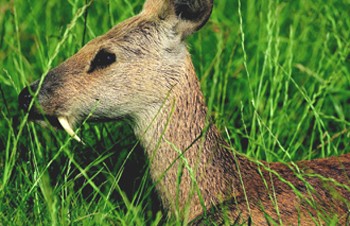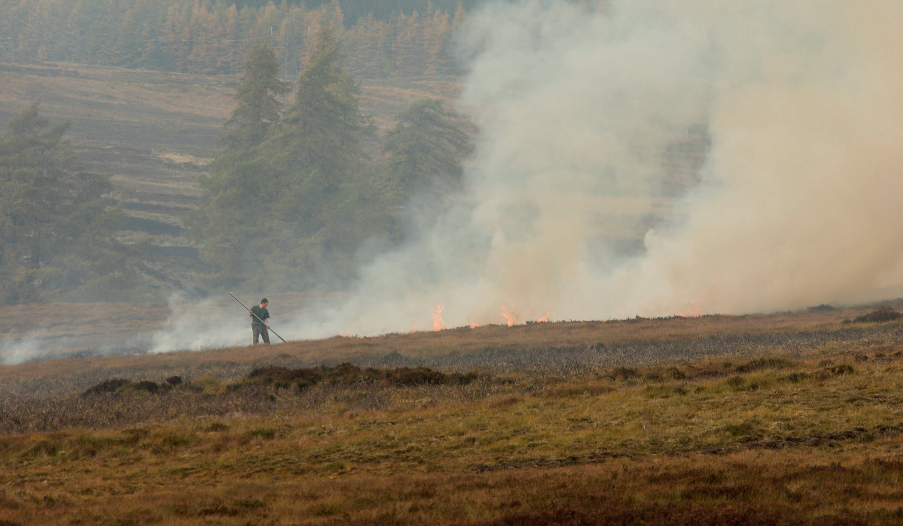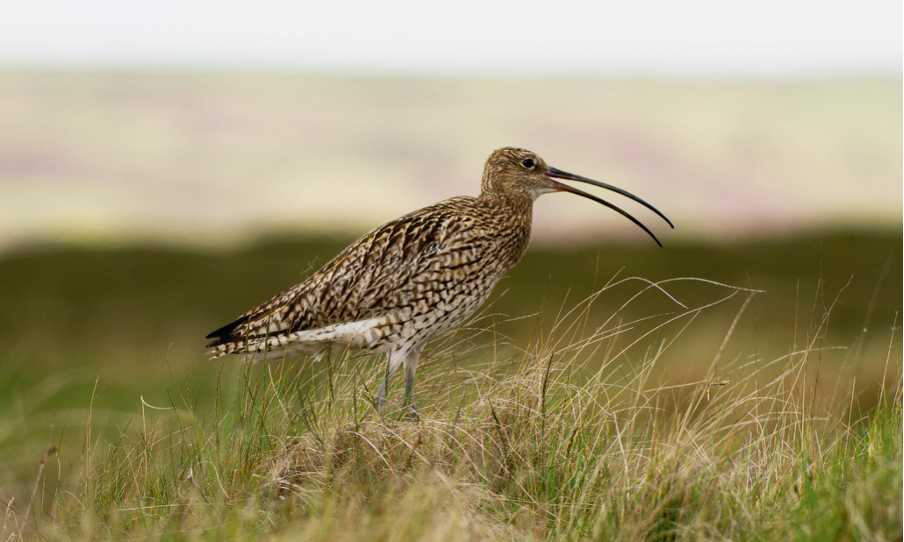News
Won over by the water deer
<strong>Bruce Potts on stalking Chinese water deer</strong>
Would you like to appear on our site? We offer sponsored articles and advertising to put you in front of our readers. Find out more.
Despite my love of deerstalking, it’s odd that Chinese water deer have somehow been off my radar. They have become very much a part of the countryside in the Home Counties, but to me they had held no real interest — until, that is, I met Mr Chinese water deer himself, Charlie Harriman.
Charlie has hunted all over Europe and in Namibia, but his guided stalks after Chinese water deer or muntjac have earned him a great reputation for giving his clients a memorable stalk. And I have to say that, having spent a day stalking with Charlie, despite some serious leg work and eye strain, I wish I had given this alien invader a little more attention, as the day was exhilarating.
What to look out for
Both bucks and does have no antlers but the bucks possess large front canines that are used as weapons, especially in the winter months, as the rut is at its height in December.
The gestation period is about 180 days and a doe can have up to seven offspring, which aids their proliferation. If you let them on to your land and do not start a proper cull plan immediately then you can soon become over-run with them. Despite having up to seven young, it is rare to see a doe with more than two or three at her side. It also seems that, as they don’t need as much woodland, they can survive in areas that roe cannot.
They can be mistaken for roe at a distance but once you have seen them up close, you notice a slightly slanted stance to the front. They are also longer in the leg but more slight in build. They have rounded ears that, being almost white and shiny in the sun, are a dead giveaway and the face is much more distinctive, with large eyes and shorter overall length.
Equipment needed
You are allowed to use a .22 centrefire rifle to shoot these deer. This means a soft or hollow point bullet of no less than 50-gr and a muzzle energy of not less than 1,000ft/lb energy.
My other fellow stalker, Julian Savory, had a custom-built Accuracy International AX rifle, but chambered in the .22-250 Ackley Improved round that fi red 55-gr bullets at 3,750fps with 1,717ft/lb energy. When sighted at 100 yards, it was only 1in low at 200 yards — perfect for the Chinese water deer.
As spotting deer is 90 per cent of the sport, good binoculars are essential, and if they have built-in laser rangefinders, all the better, as it is very difficult to judge ranges over long flat fields that have no real landmarks or scale to them.
Finally, you’ll need a good set of shooting sticks, though I chose both these and a set of Harris bipods attached to the rifle, which proved invaluable when the second deer was taken.
The importance of planning
Stalking the Chinese water deer is rather like Highland stalking. This may sound a bit odd at first, but because the deer will spend time in the middle of the fields where they feel safe, you can actually observe, assess and plan a stalk, rather like spotting a parcel of hinds or stags (though I did stalk a few mud clods, but don’t tell anyone).
The deer held fast until an hour or two before dark and then started to move out on to the fields, though some stragglers had been found earlier in the day in warm spots out of the wind, in furrows. The weather was bright but bitterly cold — 5 degrees with a really strong easterly wind that made it feel more like -5 degrees, and that raw wind sapped your energy and soon turned noses and fingers into ice cubes.
Charlie led us slowly along the low hedgerows skirting the fields, defined by deep six-foot drainage ditches then huge expanses of open space. He soon spotted an odd shape in the field. We both strained to define the blob at 384 yards and stalked in closer with Charlie’s dog, Ozzie, a black Labrador, leading the way.
Easing slowly forward with the hedgerow behind to disguise our silhouettes 384 yards soon shrunk to 200, where we stopped to have a better look. Sure enough, it was the characteristic hump of a Chinese water deer curled up in a shallow furrow in the old rape field. Its head was tucked in as a barrier against the wind, but its ears were still moving. Julian and Charlie then crawled closer, to 150 yards, and set up for a shot off the bipod, as the ground was open and because the fields are so flat you have to be extra careful to have a safe backdrop.
As the deer raised its head, Julian wasted no time, and a 55-gr Sierra despatched it cleanly with a neck shot. When we recovered and gralloched the deer, Charlie found it had both male and female sexual organs so we concluded Julian had shot half a buck.
Then it was my turn
Charlie spotted yet another odd shape in the field. Sure enough, it was another deer bedded down, though this one was alert and I had to inch my way forward to a convenient pylon to get a shot. I rested on my sticks and cradled the Predator rifle for a safe angled shot.
This was where a big .30 calibre from my .30-47L helped. At a distance of 81 yards, the heart/lung area was just on the margin of the field. As the deer rearranged its sitting position slightly, I took the opportunity and that 125-gr Ballistic Tip hit home hard, and with the deer not moving an inch. It was a doe with a lovely light beige-coloured pelage — and I had bagged my first Chinese water deer.
Getting crowded
With the light slowly fading, suddenly the deer were emerging like rabbits from drainage ditches and hedgerows. We stalked on to a promising one by walking a very long margin across muddy fields and spooked an emerging doe at 10 yards, which kept us on our toes. Then, as we crossed another ditch, Charlie and Ozzie stopped in unison — a monster buck was slowly making clear a thicket some 250 yards ahead. We all slipped slowly down the bank and Julian positioned himself to get a shot with a safe backdrop.
A real tusker
As the buck edged slowly across the fields, you did not need binoculars to see its huge tusks hanging down from its jaw like scimitars. My heart was pumping as the buck skipped towards us. Julian waited for him to turn side-on. He presented a perfect shot, and Accuracy International’s muted report from the MAE sound moderator was instantly followed by the sound of the bullet striking — and the buck dropped on the spot. When we recovered him we could see that he was indeed a monster with a very good medal head and over 3in-long tusks.
We saw 30 deer that night and I enjoyed a totally new experience. I have been stalking for 30 years and yet I felt like a beginner again with all the excitement of a new challenge. It was great sport.
Another benefit, by the way, is that Chinese water deer is probably the best-tasting venison you will eat. Its flesh may be paler than normal venison, but it’s twice as delicious.
Related articles
News
Hit pause on flawed rollout, urges BASC
BASC calls for delay to the Scottish government’s muirburn licensing scheme amid concerns from practitioners over the code’s workability.
By Time Well Spent
News
More power to police for tackling poachers
Following countryside organisations’ campaigning, penalties for illegal coursing have increased, with average fines up from £360 to £6,000
By Time Well Spent
Manage Consent
To provide the best experiences, we use technologies like cookies to store and/or access device information. Consenting to these technologies will allow us to process data such as browsing behavior or unique IDs on this site. Not consenting or withdrawing consent, may adversely affect certain features and functions.
Functional Always active
The technical storage or access is strictly necessary for the legitimate purpose of enabling the use of a specific service explicitly requested by the subscriber or user, or for the sole purpose of carrying out the transmission of a communication over an electronic communications network.
Preferences
The technical storage or access is necessary for the legitimate purpose of storing preferences that are not requested by the subscriber or user.
Statistics
The technical storage or access that is used exclusively for statistical purposes.
The technical storage or access that is used exclusively for anonymous statistical purposes. Without a subpoena, voluntary compliance on the part of your Internet Service Provider, or additional records from a third party, information stored or retrieved for this purpose alone cannot usually be used to identify you.
Marketing
The technical storage or access is required to create user profiles to send advertising, or to track the user on a website or across several websites for similar marketing purposes.



